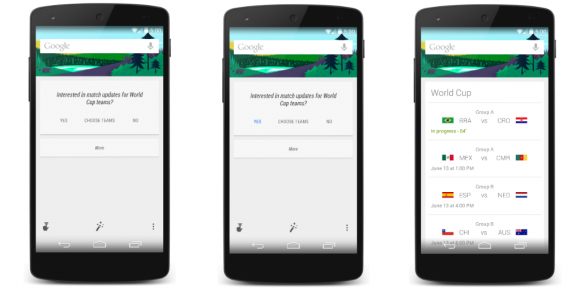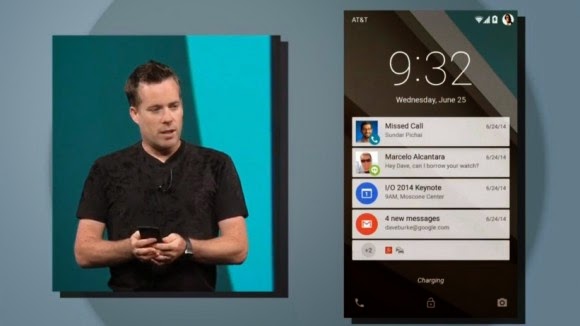Android L, or Android “L” Lollipop as it will likely be called, is here, and it’s brought a raft of new changes, with Sundar Pichai, head of Android, proclaiming it to be one of the biggest upgrades to Android yet. Android “L” Lollipop will be contextually aware of its surrounding, plus voice is going to me a major input source. The experience will also be seamless, so Android “L” Lollipop devices communicate properly, although Pichai was at pains to point out the mobile phone will always be the priority. It’s going to have a radical new design, 5000 new APIs, is already available for developer previews, and it’s going beyond the mobile form factor.
This also means that as Android L readies itself for a consumer launch, we’ll find out more about whether it’s Android 5, Android 4.5 and which dessert name it will have and indeed, it’s now looking very likely that it will be Android “L” Lollipop, as Google recently celebrated its 16th birthday with a cake topped with lollipops, which is a pretty big clue. Motorola has also confirmed that Android Lollipop will be hitting the Moto X at some point and OnePlus has committed to bringing it to the OnePlus One within three months of Google releasing a final build. “We will begin rolling out updates to the HTC One (M8) and HTC One (M7) in regions worldwide within 90 days of receiving final software from Google, followed shortly thereafter by other One family members and select devices.” Remember, this doesn’t mean the developer preview, but the final version later in the year. HTC has already been in contact, giving the following statement about its forthcoming upgrade to Android L: “HTC is excited about the new features in Android L and we can’t wait to share them with our customers.
Here’s what most of you will be wanting to know: when can I get it on my phone? Well, if you’re a developer with a Nexus 5 or Nexus 7 then it will be easiest, as it was made available on June 26 for developers. For the rest of the folk in the world, it’s coming ‘this fall’, which means that this is very much a preview to appease those that want to get cracking on development, and launching it at Google IO makes sense. So expect Android “L” Lollipop on your HTC One M8 and M7 around Christmas.
Material Design
The home, back and multi-tasking window buttons on Android have been refined too, and overall, this is a massive step forward for a cleaner, more intuitive-looking version of Google’s mobile platform. The big news for Android “L” Lollipop is the change to the way it looks, and it’s going well beyond the mobile phone to the tablet, TV screen, watch and even the car. The new Material Design is strange in that it bucks a trend at the moment: yes, it’s flat, but it’s heavily based on making every animation, every ripple, every shadow looks real, which is something that most brands are shying away from. To get a taste of Material Design now just head on over to the Play Store on an Android device, as that’s already been updated to fit the new look. The idea of obvious: remove the fragmented way Android looks and bring consistency to the app world no matter what device you’re on. Google tells us that this feels more intuitive, which means that there will be shadow gradients, 3D tiles that slide over one another and most importantly: access for developers to use this for themselves in their apps. Roboto font has been updated too, so everything from watch to TV to mobile looks the same. Every animation on screen will be allowed to connect to one another, so there’s no ‘teleportation between apps’.


Notifications and lock screen
The notification panel is being merged with the lockscreen so you can see what’s going on as you pick up the phone, and a simple swipe up takes you into the phone. Notifications on Android “L” Lollipop are getting an overhaul, so only the more relevant information about your apps is being presented. Another big change is that notifications will flow over the screen at the top, get a call when you’re playing a game and it will pop up at the top, asking if you want to take it.
Android “L” Lollipop will also learn from you, working out what you look at and interact with more often to prioritize that notification. The lockscreen is getting smarter too, if you’ve got a specific location set up, or are wearing a Bluetooth device, the phone will recognize you and unlock without a PIN. Imagine that the lockscreen is similar to the notification panel now, and you’re pretty much there.
Move away or take your watch off and you’ll need to tap or swipe in a code when you unlock, or you can even use your voice.
Interlocking apps
The idea goes much deeper than that though. Chrome browsing has an API that other apps can take advantage of, so if you click a link to book a table in the browser you’ll be taken to something like OpenTable directly, rather than the mobile site. Google wants your apps to be able to talk to one another – it used the example of searching for a place, only to have it served up in Google Earth, which is where it originally was being looked at.
Android L is Faster, better looking and more efficient
Working with NVIDIA, Qualcomm, ARM and Imagination Technologies Google has designed the Android Extension Pack with the sole task of closing the gap between mobile and desktop-class graphics, which will result in “more realistic environments, more realistic characters and vastly improved lighting”. If you’re interested, here are the finer details: ART, an optional runtime in Android KitKat, has now been made the standard for Android Lollipop and works with ARM, x86 and MIPS platforms and runs twice as fast as the Dalvik runtime that is found in previous Android iterations. ART is also 64-bit compatible, allowing Android L to benefit from the larger number registers, cross platform support and the increased RAM support that 64-bit architecture supports. Whilst Android comes with some nifty new features that make an immediate visual impact, Google has put a lot of work in behind the scenes to ensure that Android “L” Lollipop is the fastest yet. Android “L” Lollipop also allows mobile devices to further close the gap not only between mobile and console-quality gaming, but also between mobile and PC graphics. ART is also more memory efficient than Dalvik meaning that apps that are running in the background will benefit from megabytes of saved data. The biggest benefit to users comes that this won’t require apps to be readjusted in order to benefit, instead all apps with benefit from ART right away.
Batteries on phones running Android “L” Lollipop are going to become more efficient with Project Volta, Google’s new way of showing why and how a phone’s power pack is juicing down. ArsTechnica put the new OS version to the test and found that a Nexus 5 running Android “L” Lollipop had around 36% more battery life than one on Android 4.4 KitKat. Even without Battery Saver mode Android “L” Lollipop could do wonders for battery life. Not an extreme power saving like on the Samsung or HTC phones, but still useful to have baked in, even if all and sundry already have a likely more efficient version on board. It opens up the battery use to developers so they can see what’s ruining the experience, which should in turn help plug the gaps in power leakage.
When a watch is connected to a phone, it will look to see if any apps have watch compatibility and show them right on your wrist, no need for separate apps to download, a la the Samsung Gear range. And most of the watches that are out or announced so far are water resistant too, including the Moto 360, LG G Watch and Samsung Gear Live. We saw a lot more about Android Wear, which has since arrived on a number of smartwatches with manufacturers presumably trying to get their wearables on the market before Apple throws its hat into the ring with the now-announced Apple Watch. The watch (whichever you have) is a very much voice enabled, allowing you to play music on your phone or other connected devices. The LG G Watch and Samsung Gear Live are available on the Play Store. Do you really want to take off your watch and hand it over? Google Maps is giving turn by turn navigation on your wrist as well now, finally. And the whole thing has been opened up with an SDK, so developers can write code right to the wrist itself, in a very similar environment to what they’re used to, so apps should be super-snazzy right from the start.
The idea is future versions of Android (i.e Android 5) will allow the software to harness “fitness data from sensors on your Android device.” Pichai has essentially confirmed this is going to be baked into the hardware and the software side of things, telling Bloomberg that it made no sense to have to go to the doctor to measure a variety of health elements when technology can do it daily. A more recent idea is that Google’s next version of Android will have more fitness smarts built in, and this is an idea we think has legs, if you’ll pardon the sort-of pun. It also looks like Android 5 may add support for 64-bit processors, as the Nexus 8 is rumored to have one and to be running the new version of Android (if it turns out to be a real device, chances are it won’t appear just yet). It seems Google wants to do the same thing, its recently-launched Android Wear platform already has companies like LG and Motorola signed up, and Samsung is rumored to be joining the party too. Apple is set to launch the iWatch and iOS 8 with fitness very much at the heart: Cupertino looks very likely to be bringing something that’s able to track your heart rate, blood glucose and other vital medical info before shooting it over to your doctor. A recent image of ‘Android L’ (which is presumably Android 4.5 / 5) appears to show the browser floating in the middle of the screen, which may mean we’ll be getting split screen apps. Some have speculated that Android 5.0 will be actually Chrome OS, Google’s high power operating system for its Chromebooks – that it would use Android for low, to mid-level handsets and put Chrome on the high end.
It may not be called Android 5 though, with some rumors suggesting the next major iteration from Google’s wheel house could arrive as Android 4.5. That would make sense as we’ve had 4.0, 4.1, 4.2, 4.3 and 4.4 in recent years. We thought it would have been Key Lime Pie that showed off the next level, but on 31 October 2013, Google officially revealed its next minor update, Android 4.4 KitKat, which now clears the road for Android 5. So say you are searching for something like ‘Breaking Bad’ on the phone (when connected to the Android TV) it will show you the option to watch it on Google Play or any other compatible app installed. It’s called Android TV, surprisingly, and after the failure of Google TV the brand is having another go, such was the popularity of the Chromecast. Google saves the change to a new number for the big things, and it seems Android L is now on its way, ready to be debuted at Google IO on June 25. However, the latest leaks point simply to Android L, given Android head honcho Sundar Pichai said the conference would give the world an early look at the new OS, chances are the name will be held back until closer to launch, which may be later in the year. That said, it appears Google may have just dropped a hint as to the version number of the next iteration of Android. Then again, a new Screengrab of the KitKat Easter egg shows a new pudding, is that a hark to the possible Key Lime Pie that was usurped by KitKat, or are we looking at Lemon Meringue Pie? Android 5.0 Lemon Cheesecake or Android 5.0 Lemon Meringue Pie, anyone? Though there’s talk that it might be called Android “L” Lollipop or even Android Moonshine, as it’s apparently internally known. Search is well-integrated too (through the mobile phone or even an Android Wear watch), with Android TV very much powered by voice. And here’s the great news: Android TV has been signed up by some big names; the likes of Sony, Philips and Sharp have whole 4K ranges based on Android TV.
Multiple user accounts
Multiple user accounts have been available on Android tablets since 2013, but so far phones have gone without the feature, which allows you to limit what things children, co-workers or anyone else who isn’t you can access on your device. However a Google employee recently confirmed that the feature would be coming to smartphones as part of the next public Android build.
The Google Nexus 5 launched Android 4.4 at the tail end of next year, and while we’ve been waiting for the update to the big-screen tablet, the Nexus 10 (2014) doesn’t look like it’s appearing any time soon. Sundar Pichai, Google’s new head of Android told Wired that 2013’s IO was “not a time when we have much in the way of launches of new products or a new operating system”,” which makes us wonder when the new software will be coming. We’re expecting Google to make Android 5 rather special indeed, which means it can only wait a maximum of 6-7 months after KitKat was announced to show it off, so it’s a relief to hear it’s appearing, in some form at least, at the conference. The first handset to run Android 5 will either be a Nexus phone or tablet, and given the timing of the announcement we think it might be the latter. Will it be known as a Nexus though? The scheme is under threat from Android Silver, but it doesn’t look like that’s launching yet, so we reckon the Nexus name will be kept for at least the next round of devices. That’s a year on from when we had originally expected to see Android 5.0, which was at Google IO 2013, but Google has been keeping things within the ‘4.x’ family for a while now. In any case Google I/O is set for June 25-26, so with any luck we should know lots, lots more about what Android “L” Lollipop will be bringing to the table soon. We’re also hearing a lot of rumblings about a Nexus 8, a slate which will supposedly launch with Android 4.5, so maybe that’s the device that Android “L” Lollipop will make its debut on. More recent reports of Android 4.5 being next in line may mean the update is more iterative than sprawling overhaul, so we’re not getting too carried away just yet.
Our take: Android updates are still operating too slowly for our liking, as while each 0.1-numbered upgrade is good, it’s not enough to make us want the native experience. Given Android 4.4 KitKat appeared on 31 October, we’re looking forward to finally seeing a big step forward for Android. The good news is we’re going to get our first taste at Google IO, the search firm’s annual two-day developer conference in San Francisco.
While little is known about the potential interface changes for the next iteration of Google’s mobile platform, be it Android 5.0 or Android 4.5, a screenshot has appeared online claims to reveal the upcoming version. There’s a clear visual overhaul present in the screenshot, and according to the leak the new design is being referred to as “Moonshine” internally at Google. We’ve also caught a glimpse of how the dialer might look in Android 4.5 / Android 5, courtesy of an image leaked by Google itself. It’s not in for a radical redesign, but if the image is to be believed then it will be going blue, rather than sticking with the current light gray colour.
 |
| Main Interface |
 |
| Dialer Interface |
Related



















